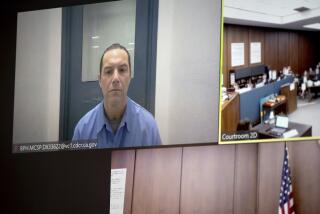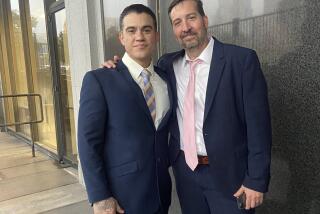Scent-Based Murder Verdict Thrown Out
- Share via
SANTA ANA — An Orange County Superior Court judge stunned a courtroom Monday when he ordered a new trial for a man who was convicted of murdering an Irvine woman in a case that was unprecedented in California because it hinged largely on evidence from a “scent machine.”
A somber Earl Rhoney, 20, entered the courtroom prepared to be sentenced to life in prison without parole by Judge Anthony Rackauckas Jr. for the 1994 murder of Patricia Lea Pratt. But moments later, he sat smiling as the judge threw out the jury’s December 1996 verdict, saying he did not “have confidence” in it.
Rhoney, a high school student at the time of the killing, was arrested after a bloodhound identified him from a scent extracted from the victim’s sweatshirt, preserved for nine months in an evidence freezer. He has steadfastly maintained that he is innocent.
Deputy Public Defender Sharon Petrosino had asked for a new trial on the basis of the bloodhound evidence and other factors. She was overjoyed and initially speechless at the judge’s surprise decision.
“It’s not often that a judge has the integrity to do what he thinks is right,” Petrosino said. “He has to face a lot of people, and it’s tough. It takes a lot of guts.”
Deputy Dist. Atty. Debbie Lloyd, who prosecuted the case, consoled the victim’s husband and mother outside the courtroom after the ruling.
“I am stunned and disappointed,” Lloyd said. “Twelve jurors took 2 1/2 months out of their lives and they considered the evidence. They felt comfortable with the decision.”
The prosecution contended that Rhoney was burglarizing Pratt’s home on Jan. 20, 1994, when the 46-year-old woman returned from a walk and surprised him. Her husband found her strangled, bludgeoned body when he returned from a business meeting.
*
A substantial amount of testimony hinged on technical aspects of bloodhound tracking and the machine, a Scent Tracker Unit 100. The tracking method involved a vacuum device that draws human scent from fabric and transfers it onto a sterile gauze pad.
Police targeted Rhoney, then 17, as a suspect two weeks after Pratt’s slaying when he was linked to a burglary in Turtle Rock, the Irvine neighborhood where the victim lived and near where Rhoney lived with his grandfather. A bloodhound named Duchess and her trainer, Larry Harris, were called in a few weeks later to help with the investigation.
But investigators had to wait nine months before they could try to have the bloodhound identify Rhoney because the teenager was by then serving time at Orange County Juvenile Hall in Orange on unrelated burglary and weapons charges.
It was logistically impossible to perform the bloodhound procedure while he was in custody, police said.
On the day of his release, Duchess and Harris were waiting. Investigators unsealed the gauze pad and gave it to the dog to sniff. Within minutes, Duchess picked out a surprised Rhoney at a shopping center, where he had gone to make a phone call.
The use of bloodhound tracking evidence has long been established in courts across the country, as long as certain conditions are met.
Judge Rackauckas said Monday that when he ruled last July that this particular bloodhound evidence could be presented during the trial, he did so even though parts of the traditional foundation for allowing such evidence were missing in this case.
The judge said testing of the machine had convinced him that those foundations could be “stretched.” But, he said, it became “crystal clear” during the trial that the scent machine evidence became dependent upon the credibility of dog handler Harris, whom Rackauckas described as “biased as any expert this court has ever seen.”
“Some of the things he was asking the jury to believe were, I’m not going to say preposterous, but certainly hard to believe,” the judge said.
Rackauckas was particularly troubled by a portion of Harris’ testimony in which the dog handler testified that Duchess followed Rhoney’s scent across the City Drive from Juvenile Hall to the shopping center.
*
“The dog did not follow Mr. Rhoney on City Drive but was taken to a crosswalk and crossed when the light was green,” the judge said. “Mr. Harris insisted the dog crossed because that’s where the scent was. That’s one of the areas that makes it difficult to believe in Mr. Harris’ credibility. [Harris] simply will not be open about whether or not the dog could be mistaken.”
Harris could not be reached for comment Monday. But Irvine Police Lt. Tom Hume defended the dog handler, who has been used frequently by the department.
“Larry Harris believes in his animals,” Hume said. “Obviously, the judge had concerns that we don’t share.”
More to Read
Sign up for Essential California
The most important California stories and recommendations in your inbox every morning.
You may occasionally receive promotional content from the Los Angeles Times.













